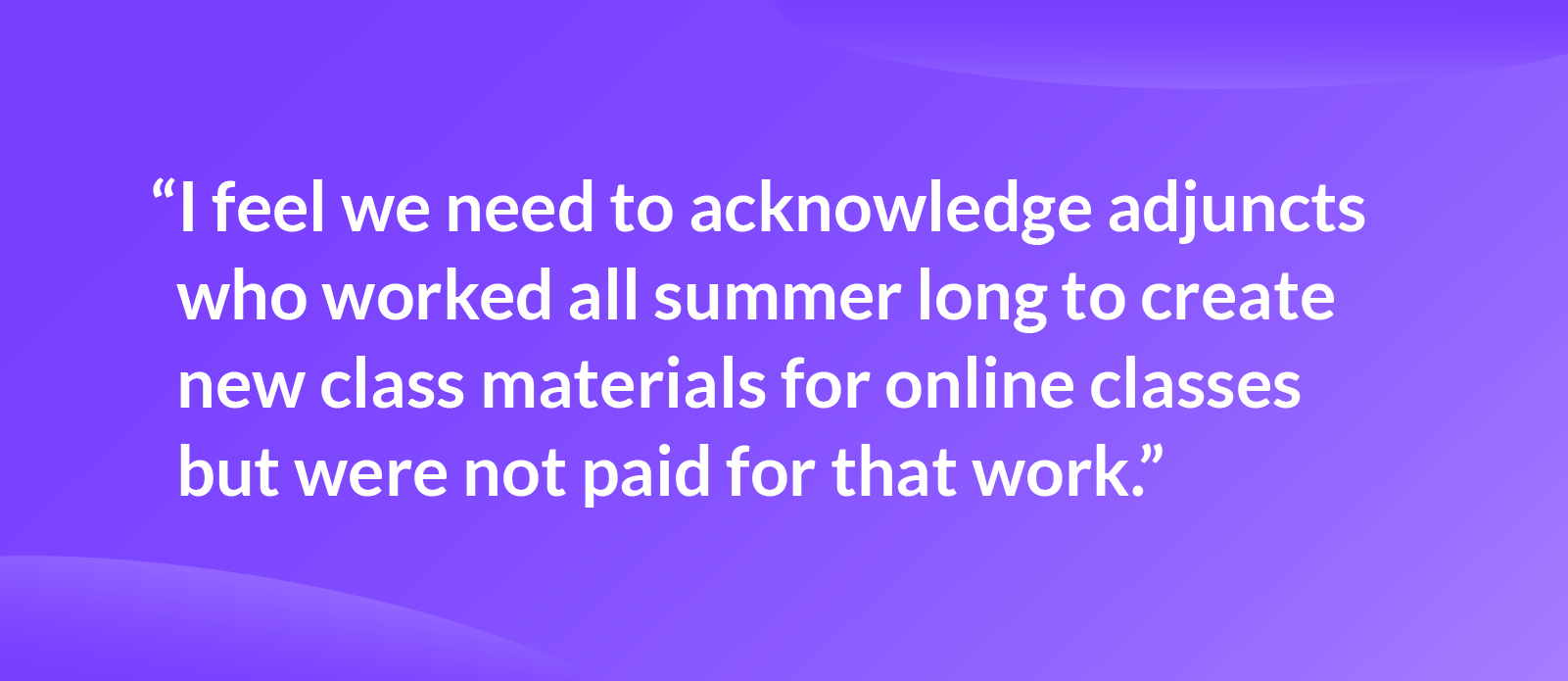
We get it: 2020 has been a year that virtually all of us in higher education would love to forget.
The unprecedented level of uncertainty, confusion, and disruption have been overwhelming. Campus closures and abrupt transitions to online/hybrid instruction; testing and tracing to ensure the health of students, faculty, and staff; calls to justify the value of higher education itself – the waves of critical challenges and concerns keep rolling ashore.
Throughout all of this, the outcomes achieved – and failures suffered – range widely across the board, particularly when it comes to the quality of education that students and their families paid for vs. the educational experience they’ve actually received.
As we look to what the spring sessions will bring, higher education is coming under even greater scrutiny for the decisions their leaders have made – and are expected to make. Despite the truly monumental efforts by many in higher ed to do what’s best for students this past year, it’s hard to find anybody who genuinely feels good about how it’s all turned out.
Like what you're reading? Subscribe to the Higher Ed News Brief, and receive the industry's top news stories delivered straight to your inbox every Monday, Wednesday, and Friday.
Blame Runs Rampant
The inevitable – and not entirely unwarranted — blame game began months ago. And there’s plenty to go around. University leadership, trustees and governance bodies have been called to the carpet – rightly so, in many cases, wrongly in others — for what many believe is their strategic, fiscal, and operational short-sightedness at “best,” and outright mismanagement at the worst.
What could have been done better, what should have been done better, are important discussions to be had. But these are not the only critical conversations that need to take place.
Appreciation is in Short Supply
As we look to move beyond the past year – to do better – it is important to recognize those who stepped up in a big way these past ten months, the steadfast contributors whose commitment and dedication to the core principles of higher education have largely been overlooked during all of this – the faculty and staff who support the students we all serve.
Let’s begin by recognizing that it’s easy to lump responsibility and blame into a single existential bucket called “higher ed,” but it is more complicated than that. While senior higher ed administrators made the critical decisions, it’s been faculty and staff who have been called upon to implement classroom and remote instruction policies they likely had little input in creating.
By all accounts, they’ve stepped up enormously and deserve the lion’s share of credit for delivering the highest level of education possible under extremely difficult circumstances this past year. Now that fall sessions have come to a close, it's important to recognize what they’ve been through, that many are burned out, need a rest, and – importantly – are the ones who should have a bigger say in how the spring sessions will be conducted.
Related Reading: 3 Examples of COVID-19's Positive Impact on Higher Education
The First Step is to Listen
We crowdsourced the direct input of faculty, staff, and students on higher education-specific social media groups over the past month to get a good look at how many of them have been going above and beyond despite the tremendous upheaval they faced this past year.
A few themes emerged, but what stood out most to us is just how much happens between faculty, staff, and the laptop screens of students trying to learn remotely from places far and near – efforts that even many in higher ed might not see, let alone appreciate.
If there is one thing that resonates above all others, it would be that educators, staff, and support-level administrators have made infinitely more sacrifices than we may know about to ensure quality education was delivered to their students.
Below is a little of what we heard.
Extraordinary Personal Sacrifice

Faculty, staff, and admins have been making personal sacrifices to ensure students were cared for and supported during the pandemic. The efforts of university support staff across the US speak volumes.
“We housed and fed stranded students during the summer, enlisting virtually all stakeholders involved – alumni, donors, staff, faculty, and parents to contribute to the cause. Some even welcomed students into their homes. We added virtual grief support groups for impacted students. We transformed our entire internship system almost overnight to a virtual internship system.”
“For a trans student whose transition treatments were interrupted because their mom has cancer and everyone was staying home trying to avoid bringing the virus into the home, I offered to complete their exams as oral exams, which allowed them to continue learning and pass the class.”
“We started every class with a check-in to see how students were doing. We talked about isolation, fear for loved ones, why some communities were being harder hit, election stress, the fraught nature of decisions made, worries about job prospects, etc. While campus was closed, we delivered groceries and staples to high-need international students living off-campus.”
Related Reading: The Impact of COVID-19 on Alumni Relations in Higher Education
Another example of going above and beyond personally comes from faculty members at another college:
“In May I had a student reach out to me in crisis. It turns out her home was not a safe environment, and in the past, Residential Life made exceptions for her to stay on campus when others typically wouldn't be. When our campus shut down, she was forced to return home. She called me from her car, crying after an incident with a parent. She had grandparents she could go to but was afraid to because they were high risk. My colleagues and I scrambled to find shelter information and connected her with support in her hometown.”
“For many students, the campus is where they are safe, and that safety was jeopardized when all students were forced to return home without any time to plan. We did everything we could to ensure that students were in a safe environment conducive to learning.”
Related Reading: COVID-19 Amplifies Existing Inequalities for Black College Students
Doing Whatever is Necessary
Sometimes faculty and administrative support staff have had to figure out new ways to ensure students were informed, cared for, and supported on an institutional level, even if the solutions required time-intensive processes with decisions being made on the fly because waiting simply was not an option:
“Our HR Call Center team stepped up to become our primary COVID-19 Response Call Center, fielding thousands of calls and emails, mainly from parents and students. This allowed our frontline staff in Student Affairs, Student Health, Housing, and other areas to focus on their specific responsibilities, which were critical to putting into effect the changes that needed to be implemented on the ground.”
“Our Academic Advisors deserve much more recognition than they’ve received for their willingness to serve as advisors and counselors beyond “mere” academic recommendations. Underpaid and overworked, they have served as the frontline source of support for students nonstop, shepherding them through total chaos without pause or any expectation of praise or reward.”
Extra Work, No Extra Pay

Faculty, staff, and support-level admins aren’t the most well-compensated positions in higher ed to begin with – far from it – yet countless employees worked overtime, day-in and day-out, to ensure the semester went as well as it could for their students. They neither asked for nor were offered extra pay – they did what it took.
“I feel we need to acknowledge adjuncts who worked all summer long to create new class materials for online classes but were not paid for that work.”
“Faculty at our college were tasked with transitioning face-to-face classes into online classes with no notice, no training, and an unwieldy LMS for online education without complaint, without demands, and without putting an undue burden on students.”
“A colleague and I created remote learning study skills videos for students to help them acquire strategies for succeeding in a remote classroom environment. We did this on our own time because we felt students really needed it and couldn’t find anything out there that made any sense.”

Fatigue, Stress, and Burnout Mounting

All this stepping up has led to faculty burnout, and mental health challenges for staff and admins.
“It’s our job to get students to learn, and when our students are stressed from other things like social isolation or living at home that interfere with their learning, we are stressed.”
“One major factor is compassion fatigue, and that has everything to do with educators having to carry the weight of student stress. Students have been depending on educators to provide help and advice, as well as make the right decisions regarding COVID-19. Educators hurt when their students are hurting. The stress of faculty is deeply linked to stress of students.”
All is Not Lost – Students Share the Love
The good news in all of this is how appreciative many students have been for these extraordinary efforts to help the whole person, not just the academic learning side of struggling students.
While those examples can be found across the country, one group of students recently found the perfect way to express their gratitude to their professor.
As reported on NBC’s Today Show, College of New Jersey statistics professor Adam Shrager logged onto Zoom to teach his class only to find that all of his students had turned off their video function – all the squares were black when typically, 90 percent of students joined via video.
Logging in and seeing no faces at all was very strange,” said Shrager. “All I could think was that my internet was slow or something. And then, in unison, each square turned on to reveal his students holding up signs of gratitude for his dedication. Some merely read “THANK YOU!” while others featured creative references to the statistics lessons they had learned, such as "You are in the 99th percentile of my all-time favorite professors."
As their cameras clicked on, and I started reading the signs, I was overcome and truly moved,” Shrager recalled, “even a bit teary. It was incredible and sweet." One of Shrager's students captured the moment on camera and shared it on TikTok. The post quickly went viral and has since been viewed more than six million times.
A fitting reminder for us all that sometimes – even during, or perhaps, especially during – this year’s COVID-19 pandemic, what goes around really does come around.









